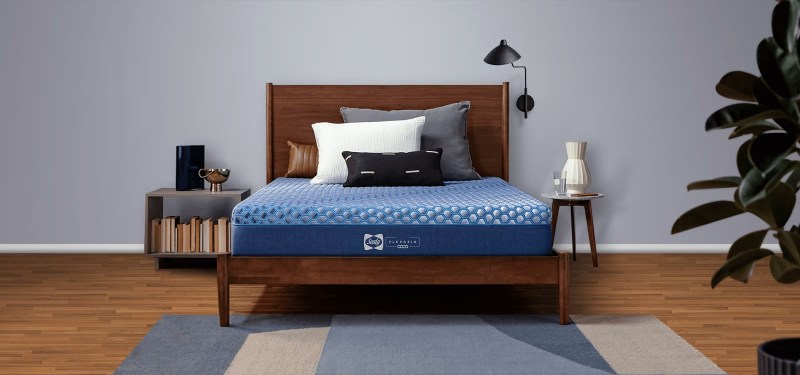
There are plenty of tips and tricks you can try for getting a good night’s sleep — eating a bowl of oatmeal at night, turning off your screens a suitable amount of time before bed, and even when you choose to shower can all play a role in getting some much-needed shut-eye. But the foundation to a good night’s sleep is … Well, your foundation. Without a high-quality mattress suited to your sleeping needs, you’ll be tossing and turning all night.
Sealy is one of the most respected mattress brands around, with a wide range of products: Sealy Naturals, Sealy Posturepedic, Sealy Posturepedic Plus, Cocoon by Sealy, and of course, the Sealy FlexGrid mattress. This last one comes in both 10-inch memory foam and 12-inch hybrid options. Both are offered in multiple sizes: Twin Long, Full, Queen, King, California King, and Split California King.
For the purposes of this review, we tested a queen-size, 10-inch Sealy FlexGrid memory foam mattress for a period of four months.

Features of the Sealy FlexGrid mattress
What do you get with the Sealy FlexGrid memory foam mattress?
- Sealy’s HexGel technology. Made from a hyperelastic polymer, the honeycomb-shaped gel grid is designed to minimize motion transfer to ensure fewer disturbances when you sleep. It stretches when under pressure and returns to form once that pressure is relieved — meaning it was designed with back, side, and stomach sleepers in mind and can help relieve back pain and minimize pressure on problem areas like shoulders, knees, and hips. The honeycomb-shaped pockets also offer a degree of breathability that not many other memory foam mattresses afford.
- In addition to the gel grid, the Sealy mattress also features pressure-relieving foam.
- A soft-knit cover with SealyChill cooling fibers. These fibers are cool to the touch and are designed to work with the gel grid to keep you from overheating when you sleep.
- This Sealy mattress is CertiPUR-US certified, which means it’s a low-VOC foam that’s free from harmful substances like ozone depleters, mercury, lead, and other heavy metals.
The 12-inch hybrid model also comes with the following:
- Spring, foam, and grid construction
- Extra edge support
Both models offer:
- A 90-night trial
- Free delivery
- A 10-year warranty

What we like about the Sealy FlexGrid mattress
- This mattress was great for both side sleepers and combination sleepers. All pressure points were well supported throughout the night when sleeping on our sides, and combination sleepers didn’t struggle to turn to a more comfortable position. While some mattresses take the full 90 days of a trial to feel comfortable (or at least a week or so), this mattress was comfortable from day one.
- The pressure-relief technology. According to Sealy, the HexGel grid means the mattress is “neither firm nor soft — it adapts and responds to the pressure being applied to create a floating feeling.” While this sounds like marketing speak designed to appeal to those who like firm mattresses and those who like soft mattresses, it really does seem accurate. It’s a comfortable mattress to sleep in, but you absolutely feel like you’re sleeping “on” the mattress and not “in” it. There’s no struggle to get out of bed in the morning like you’ve accidentally fallen asleep in a beanbag chair.
- Solid motion isolation. Motion transfer was minimized, so if you sleep with a partner (or pets or kids), you’re unlikely to disturb each other during the night.
- The cooling technology delivers. We tested this mattress through one of the hottest summers on record and didn’t wake up sweating once. The HexGel layer sits between the comfort layer and support core, adding a measure of breathability that other all-foam mattresses don’t have.
- There was minimal off-gassing — about what you would expect from an all-foam mattress.
What you should consider before buying the Sealy FlexGrid foam mattress
- It’s not available in a traditional twin size. Twin XL is a great option for kids with small rooms — it doesn’t take up the space of a full-size bed, but a teenager won’t outgrow it as fast (and if you place it in your guestroom, it will be more comfortable for guests). But if you already have a bed frame for a twin bed, this might not be the best option for you.
- Those looking for more edge support may want to consider the hybrid option with its reinforced perimeter. There was definitely some sinkage when sitting or lying near the edge of the all-foam mattress, though it seemed on par with other all-foam competitors.
- Make sure you have the right foundation for your mattress. This is compatible with an adjustable power base, flat foundation, and platform bed (but it’s not compatible with a box spring since it needs a solid base).
Should you buy the Sealy FlexGrid foam mattress?
If you’re looking for an all-foam mattress that sleeps cool and relieves pressure, the Sealy FlexGrid is a solid choice. There’s minimal motion transfer, which minimizes disturbances at night, and the mattress firmness adapts to you without ever feeling like you’re sinking into the mattress. The all-foam mattress ranges in price from $1,269 to $2,538 (the queen we tried is priced at $1,569), making it an affordable option.


